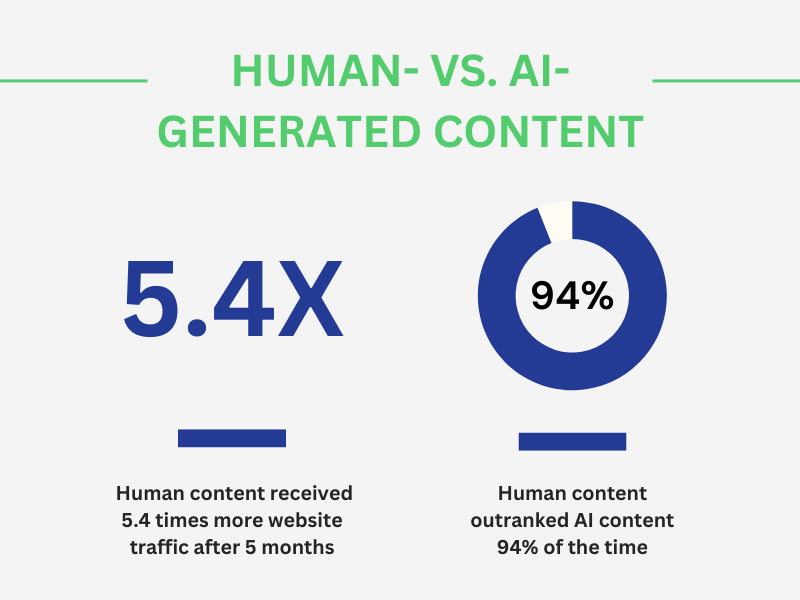Change is the one constant in content marketing. We’re living in a world where information flows freely, creativity knows no bounds, and content provides the anchor for businesses to be discovered online. For years, content marketing has been the epicenter of storytelling, customer connections, and “going viral.” But with the industry in constant flux, content marketing is like a moving target—marketers must constantly track its direction or risk losing their edge altogether.
That’s why we’ve explored the state of content marketing to learn the key trends, top channels, and best practices driving digital content forward. We wanted to know if content marketing still works and how high-performing companies are investing in content this year.
Why Marketers Depend on Content as a Cornerstone Strategy
We’re long past the days when a Google search would drum up just four pages of search results and all you had to do to rank on Page 1 was include the exact keyword in the title. The stakes for SEO are creeping ever higher, and content marketing continues to provide the foundation for brands to rank.
Research shows that 82% of companies include content marketing in their strategy. With people across all age ranges spending more time online, businesses continue to see valuable opportunities to create and use content in their marketing and take advantage of these larger captive audiences.
However, most companies feel as though their content strategies are only moderately effective. As with any type of marketing, the key is to meet your audience wherever they are in ways they welcome—without breaking the bank.
According to Statista, content marketers invested in content for a myriad of reasons in 2024, including:
- Retaining and expanding customers (59%)
- Paid advertising purposes, such as sponsored or gated content (54%)
- Driving online traffic (51%)
- Using sponsored content (51%)
- Generating leads for sales teams (49%)
- Selling content products (46%)
Overall, the content market is expected to grow by 16% per year between 2022 and 2027, for a total of $584 billion. Content budgets continue to increase year after year, proving that marketers not only find value in content but also don’t want to risk being left behind.
Does Content Marketing Still Work?
Yes, despite how noisy content marketing (and the internet as a whole) has become, marketers still look to content to help them achieve their business objectives.
According to digital marketing expert Neil Patel:
- 93% of B2B marketers use content marketing.
- Content marketing costs 62% less but generates three times more leads than native or traditional advertising.
- Conversions are 6x higher for companies that use content marketing vs. those that don’t.
As for what’s working in content marketing, it varies based on where you’re investing.
Blogs remain a leading performer in content marketing. Nearly 80% of companies continue to generate tangible marketing results with their blogs.
However, AI has introduced a number of new challenges in recent years, especially when it comes to blogging. Almost 60% of businesses are using AI for blogging—more than any other type of content. Yet, human-written content generally outranks AI-generated content, drives more traffic, and resonates better with the audience to spark your intended action.

Blogs are the low-hanging fruit for marketers who want to implement AI in their processes, but many are experiencing uncertainty, quality issues, and a lack of personalization in their outputs. Common challenges of AI-generated content include:
- A lack of originality and brand voice
- Lower content quality
- Struggles in ranking content in search engines
- No engagement
AI tools offer a range of advantages, but overuse of them can lead to institutional sameness and losing your brand voice. Finding ways to improve content tone, quality, and context will be of the utmost importance in maintaining audience trust and online visibility.
These and similar AI-related challenges might skew marketers’ views of whether content marketing works: If your content isn’t ranking, isn’t getting engagement, and sounds like every other article posted on your chosen topics, you likely won’t see the results you expect.
But that doesn’t mean content marketing doesn’t work — it absolutely does work. It’s about finding what works for your brand, creating content your audience cares about, and publishing material that’s better than what’s already been said.
Top Types of Content Marketing
With an evergrowing list of content formats and channels, marketers must find creative and efficient ways to optimize their ROI. Top marketers focus their efforts on the types of content that perform best:
- Videos
- Short-form articles
- Success stories
- Long-form blog posts
- Case studies
- Webinars and online events
- Gated content
- Infographics
- White papers
- Offline events
You’ll notice the top five content types rely on video and written content creation. Marketers are honing their time and budget on creating and updating content in these two formats. Balancing your audience preferences and algorithm criteria with your skill set will help you find the sweet spot of sustainable and high-performing content marketing for your brand.
Video Content
Video continues its reign in content marketing, with more than 50% of businesses saying they plan to invest more in video content. AI is inching its way into video production too, with 41% of marketers saying they have used AI to create or edit their videos.
The number of ways to share video content is also growing. Video platforms now include:
- Instagram Reels
- TikTok
- YouTube and YouTube Shorts
- Facebook Reels
- Facebook Live
- Twitch
- X
- Your own website
- On-demand webinars
The general public agrees video is a safe bet. Data shows that 80% of consumers prefer video and retain more of what they see compared to text only.
It’s worth mentioning that there’s a time and a place for video vs. written (and audio) content. Google is getting better at understanding the context of users’ searches and will recommend content in an appropriate format.
AI overviews tend to favor certain types of content: For technical instructions and how-to’s, Google tends to prioritize YouTube videos. However, you don’t always need an entire video when a quick list will suffice.
Ideally, opt for a multimedia format:
- Use images to visually explain your content
- Create videos for tutorials
- Add audio for more in-depth explanations
- Write structured content that clearly answers the readers’ questions
That’s the beauty of content marketing—there are so many ways to repurpose content and capture your audience’s attention. When one format doesn’t launch you to success, there are plenty of other things to try.
Written Content
Despite the ongoing push for video, blogs and other written content still hold value, with 77% of internet users sharing they read blogs. In fact, out of 1.9 billion websites worldwide, 600 million—or about a third—of them are blogs. And for those marketers who do blog, 80% say that blogging still drives strong marketing results. Blogs continue to be the most popular format for increasing brand awareness, with 79% of marketers agreeing they’re an effective way to distribute content, reach customers, and build awareness.
With AI entering search engines and ChatGPT’s launch of SearchGPT, brands have more ways to get in front of relevant audiences. Google’s new AI Mode and SearchGPT offer two highly distinct search experiences, each of which can send more traffic to your blog articles. It’s worthwhile to learn how to optimize your content for AI search engines so you can be seen by more users.
According to Orbit Media, bigger is better when it comes to blogging, with posts containing 2,000+ words reporting the strongest results in 2024. However, we believe short-form written content (i.e., anything under 1,000 words) is having a moment in 2025. In light of dwindling attention spans and readers wanting clear, succinct answers to their searches, marketers are finding favor with shorter blog content that more closely aligns with search intent. There’s also less risk of losing your readers’ attention, and shorter posts are less expensive to produce.
 ©SUWANNAR KAWILA via Canva.com
©SUWANNAR KAWILA via Canva.com
Content Marketing Channels
Creating content is just the beginning. Once you hit publish, your success also depends on how you distribute and promote your content. Not everyone will come across your content via organic search. Unless you’re a juggernaut like Amazon, Hubspot, or Gary Vaynerchuk, you’re going to need to do some work to get your content in front of the right people.
The channels you use have a lot to do with this. In addition to your own website and optimizing content for SEO, consider what others share that have worked well for them.
- For B2C brands, Facebook is the #1 content distribution channel and drives the best results.
- For B2B brands, LinkedIn remains the top choice for content distribution.
- 67% of social media marketers use Facebook, followed by 65% who use Instagram.
- Content sent via email is 45x more likely to be seen than content posted on social media.
- TikTok delivers as much as a 96% ROAS and increases sales efficiency by as much as 5.2x.
- More than half of brands plan to increase budget spend on influencers.
These stats are just the tip of the iceberg. As content marketing channels proliferate, marketers should hone in on the effectiveness of each channel, the type of content that performs best on the channel, and what characteristics contribute to each channel’s success for their brand.
How to Make Content Marketing Work for You
With the rise in AI tools that make keyword research and brainstorming a breeze, brands will need to seek new ways to make their content stand out. With Google prioritizing content that’s high quality and helpful, marketers must write people-first content with authority and expertise. See Google’s Helpful Content Self-Assessment to evaluate your existing content and learn what the algorithms prioritize.
At Content Pros, we’re helping our clients explore different ways to add depth and differentiation to their written content. Some of our favorite examples include:
- Using audio or video recordings with in-house subject matter experts
- Creating case studies using customer interviews
- Leveraging first-party data as a foundation for written content
- Repurposing webinars into lead magnets and social media posts
- Crafting original infographics or imagery
- Updating dated content
Whether you’re spending more (or less) on content marketing this year or want to experiment with the trends we mentioned, Content Pros helps you maximize your investment with quality, expertly-written content. Our U.S. writing team is comprised of subject matter experts with real-world experience, helping you establish your brand as a leading voice in your industry.
Get in touch today to learn more and receive a $100 discount on your first piece of content.

